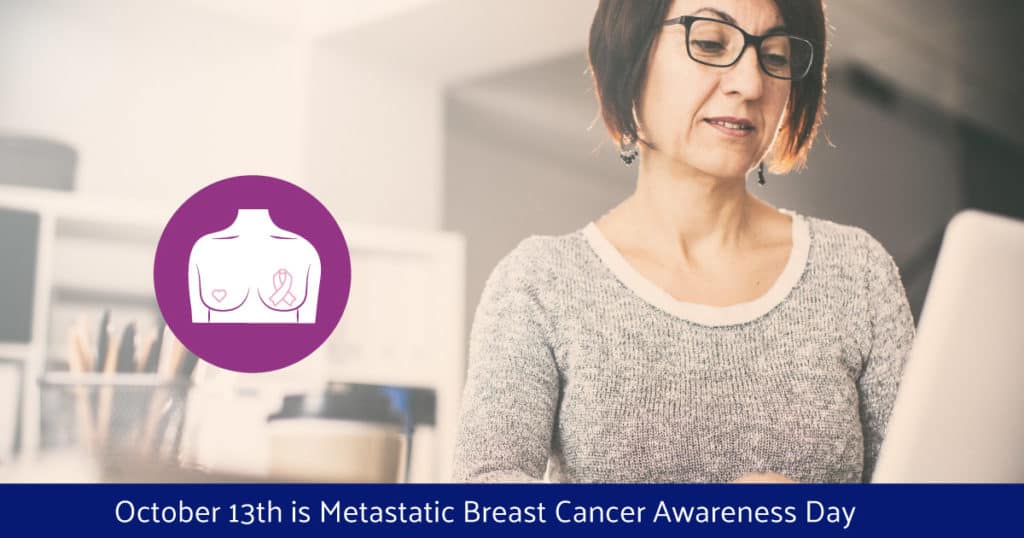October 13th is Metastatic Breast Cancer Awareness Day

By Kathleen Hoffman, PhD, MSPH
The symbol for breast cancer awareness is a pink ribbon. But for people with the disease, one month and a pink ribbon are not enough. Many cancer drugs are evaluated by the amount of time the treatment delays progression, and despite new treatments and genetic advances, the 5-year survival rate for advanced or metastatic breast cancer is still just 27%. As Judy Perkins, diagnosed with metastatic breast cancer in 2013, said, “I have little interest in pink ribbons… I don’t want a ribbon. I want a cure.”
Today, she is still alive and shows no evidence of disease (NED) after participating in a TIL (tumor infiltrating lymphocytes) clinical trial, making her perhaps the first person cured of MBC. She joined the Inspire Advanced Breast Cancer Community on Inspire in 2013, and still participates under the name Adventureswithcancer.
Perkins found out about her life-saving clinical trial through her sheer persistence to learn everything she could about her illness and its treatments — one of the reasons members and visitors come to Inspire. Inspire is a living resource of real-world data and first-person experiences. .
An article about Perkins’ treatment journey is just one part of Inspire’s Metastatic Breast Cancer online sponsored resource center, which supports the community and visitors with information about the disease, treatments, guidance on exploring clinical trials, and survivor stories. Over 115,000 members have joined our breast cancer communities, shown an interest in breast cancers, or posted or searched on the topic of breast cancer on Inspire. Other Inspire sponsored resource centers being built include ones for chronic lymphocytic leukemia, acute myeloid leukemia, ovarian and kidney cancer.
According to the National Breast Cancer Foundation, this year an estimated 276,480 new cases of invasive breast cancer will be diagnosed in women in the U.S. as well as 48,530 new cases of non-invasive (in situ) breast cancer. Breast cancer is the most common cancer in American women, except for skin cancers.
Members often discuss side effects of treatments, such as one member in the breast cancer community, who publicly posted:
[number] weeks after finishing radiation feeling shoulder pain and tightness. What should I ask doctor?
One respondent shared her experience and recommended consulting a treatment expert:
I had [number] radiation treatments, after chemo and surgery for breast cancer, which ended [date]. I still have tightness in the shoulder and surrounding tissue that was radiated. (I’ve read it’s called radiation induced fibrosis.) Physical therapy helps! …There are oncology physical therapists, so try to get a referral from your doctor for one with that specialty if you can.
Treating breast cancer today has gone beyond surgery and radiation to include immunotherapy, hormonal therapy, genetic testing for targeted therapy, and chemotherapy. Members discuss their concerns and life experiences around all of them in remarkable detail, including the conflicting information they get — even from medical professionals. For example, one member wrote:
I just had a mastectomy for breast cancer. Stage 2 Grade 1. Nothing in my lymph nodes. Im on [drug name]. Everywhere I read it says I should get a hysterectomy. Im terrified to do this. I just had an vaginal ultrasound and my fibroid has grown slightly. My GYN says its from the [drug]. My oncologist says its not from the [drug]. There is no bleeding, uterus is normal, no pain any where not even from fibroid. BRCA is negative. Im at a loss at what to do. Full of anxiety.
One reply shows the kind of support and information available within the Inspire community:
[Drug name] can cause endometrial tissue to thicken. For that reason I have an annual ultrasound and a CA 125 blood test. Talk to your doctor about having a CA125 test as a way to monitor for uterine cancer.
Remarkably, some discussions have revealed side effects and symptoms which were not previously officially recognized as part of the symptomology (see this Patient Pulse article for an example) — they were only discovered after studies of online communications among participants.
There is hopeful news and some progress in breast cancer statistics. According to the American Cancer Society, since 2007, the rate of breast cancer has decreased in older women. From 2013 to 2017, the death rate decreased by 1.3% per year. “These decreases are believed to be the result of finding breast cancer earlier through screening and increased awareness, as well as better treatments.”1 As of 2020, “64% of breast cancer cases are diagnosed at a localized stage, for which the 5-year survival is 99%”. But, at the same time, approximately “1 in 39 women (3%) will die from breast cancer.”2
Ribbons and marches do raise awareness and funds for research. The goal, however, is to have millions more women like Judy Perkins — former breast cancer patients, who now live long-term with a diagnosis of NED.
Inspire offers a trusted community to patients and caregivers. Our goal with this blog, this website and our content is to provide the life science industry access to the true, authentic patient voice. In so doing, we support faithful operationalization of patient-centricity. Take a look at our case studies, eBooks and news outlet coverage.
References:
1 https://www.cancer.org/cancer/breast-cancer/about/how-common-is-breast-cancer.html
2 https://www.nationalbreastcancer.org/wp-content/uploads/2020-Breast-Cancer-Stats.pdf






